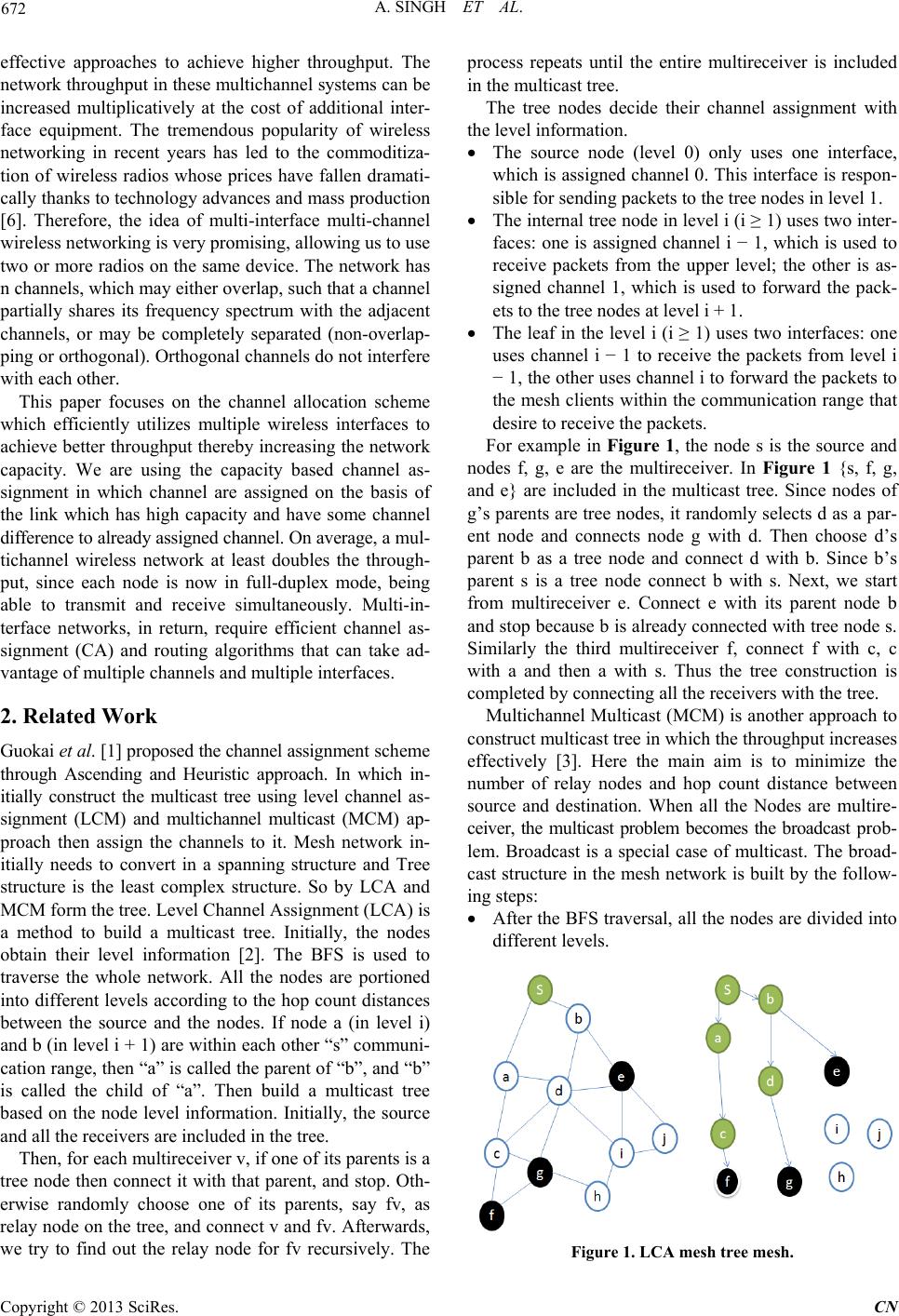
A. SINGH ET AL.
effective approaches to achieve higher throughput. The
network throughput in these multichannel systems can be
increased multiplicatively at the cost of additional inter-
face equipment. The tremendous popularity of wireless
networking in recent years has led to the commoditiza-
tion of wireless radios whose prices have fallen dramati-
cally thanks to technology advances and mass production
[6]. Therefore, the idea of multi-interface multi-channel
wireless networking is very promising, allowing us to use
two or more radios on the same device. The network has
n channels, which may either overlap, such that a channel
partially shares its frequency spectrum with the adjacent
channels, or may be completely separated (non-overlap-
ping or orthogonal). Orthogonal channels do not interfere
with each other.
This paper focuses on the channel allocation scheme
which efficiently utilizes multiple wireless interfaces to
achieve better throughput thereby increasing the network
capacity. We are using the capacity based channel as-
signment in which channel are assigned on the basis of
the link which has high capacity and have some channel
difference to al read y ass igned chan nel. On av erag e, a mul-
tichannel wireless network at least doubles the through-
put, since each node is now in full-duplex mode, being
able to transmit and receive simultaneously. Multi-in-
terface networks, in return, require efficient channel as-
signment (CA) and routing algorithms that can take ad-
vantage of multiple channels and multiple interfa ce s .
2. Related Work
Guokai et al. [1] proposed the channel assignment scheme
through Ascending and Heuristic approach. In which in-
itially construct the multicast tree using level channel as-
signment (LCM) and multichannel multicast (MCM) ap-
proach then assign the channels to it. Mesh network in-
itially needs to convert in a spanning structure and Tree
structure is the least complex structure. So by LCA and
MCM form the tree. Level Channel Assignment (LCA) is
a method to build a multicast tree. Initially, the nodes
obtain their level information [2]. The BFS is used to
traverse the whole network. All the nodes are portioned
into different levels according to the hop count distances
between the source and the nodes. If node a (in level i)
and b (in level i + 1) are within each other “s” communi-
cation range, then “a” is called the parent of “b”, and “b”
is called the child of “a”. Then build a multicast tree
based on the node level information. Initially, the source
and all the receivers are included in the tree.
Then, for each multireceiver v, if on e of its paren ts is a
tree node then connect it with that parent, and stop. Oth-
erwise randomly choose one of its parents, say fv, as
relay node on the tree, and connect v and fv. Afterwards,
we try to find out the relay node for fv recursively. The
process repeats until the entire multireceiver is included
in the multicast tree.
The tree nodes decide their channel assignment with
the level information.
• The source node (level 0) only uses one interface,
which is assigned channel 0. This interf ace is respon-
sible for sending packets to the tree nodes in level 1.
• The internal tree node in level i (i ≥ 1) uses two inter-
faces: one is assigned channel i − 1, which is used to
receive packets from the upper level; the other is as-
signed channel 1, which is used to forward the pack-
ets to the tree nodes at level i + 1.
• The leaf in the level i (i ≥ 1) uses two interfaces: one
uses channel i − 1 to receive the packets from level i
− 1, the other uses channel i to forward the packets to
the mesh clients within the communication range that
desire to receive the packets.
For example in Figure 1, the node s is the source and
nodes f, g, e are the multireceiver. In Figure 1 {s, f, g,
and e} are included in the multicast tree. Since nodes of
g’s parents are tree nodes, it randomly selects d as a par-
ent node and connects node g with d. Then choose d’s
parent b as a tree node and connect d with b. Since b’s
parent s is a tree node connect b with s. Next, we start
from multireceiver e. Connect e with its parent node b
and stop because b is alr eady connected with tree node s.
Similarly the third multireceiver f, connect f with c, c
with a and then a with s. Thus the tree construction is
completed by connecting all the receivers with the tree.
Multichannel Multicast ( MCM) is another approach to
construct multicast tree in which the throughput increases
effectively [3]. Here the main aim is to minimize the
number of relay nodes and hop count distance between
source and destination. When all the Nodes are multire-
ceiver, the multicast problem becomes the broadcast prob-
lem. Broadcast is a special case of multicast. The broad-
cast structure in the mesh netw ork is built by the follow-
ing steps:
• After the BFS traversal, all the nodes are divided into
different levels.
Figure 1. LCA mesh tree mesh.
Copyright © 2013 SciRes. CN